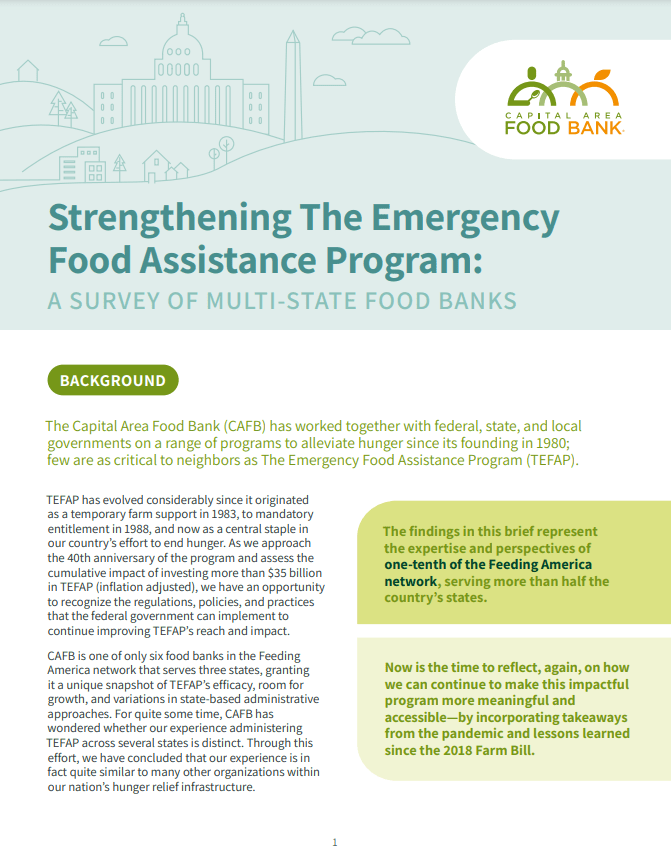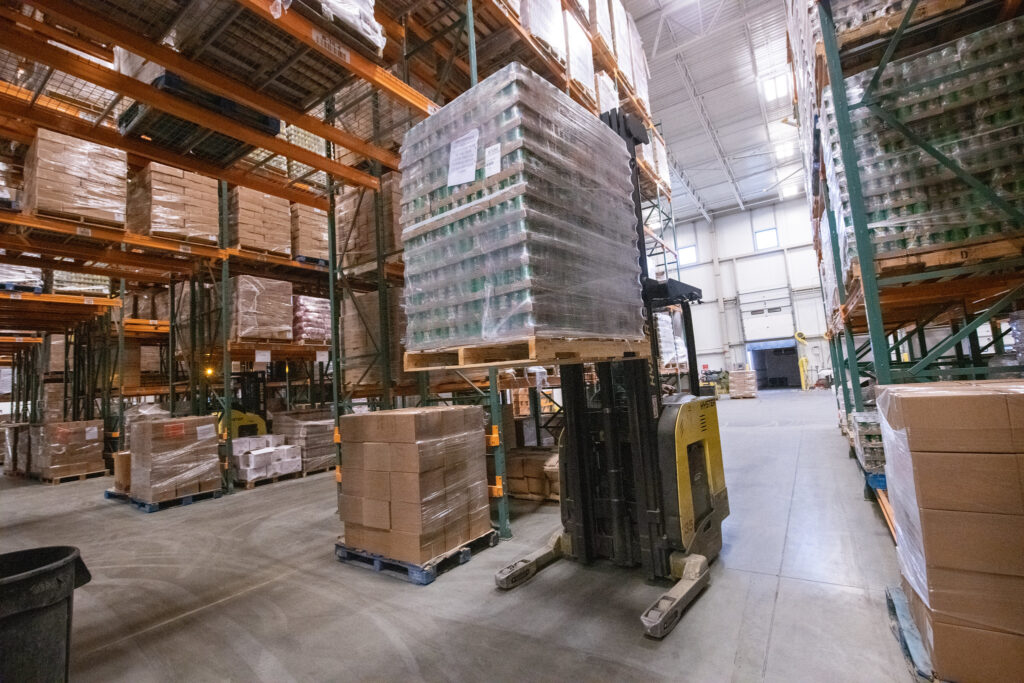The Capital Area Food Bank has worked with federal, state, and local governments on programs to alleviate hunger since its founding in 1980.
Few are as critical to neighbors as The Emergency Food Assistance Program (TEFAP).
The Emergency Food Assistance Program, or TEFAP, is a federal nutrition program that moves food from farms to food banks to people facing hunger. The U.S. Department of Agriculture purchases healthy foods from U.S. growers and producers, and food banks and other organizations work with states to distribute this commodity food at no cost.
The Capital Area Food Bank is one of only six food banks in the Feeding America network that serves three states, granting us a distinctive perspective on TEFAP’s efficacy, room for growth, and variations in state-based administrative approaches. For quite some time, we have wondered whether our experience administering TEFAP across several states is unique.
The Effort to Build Upon TEFAP’s Success
In the winter of 2021, we began discussions with Feeding America, the United States Department of Agriculture, and food banks throughout the country with multi-state service areas to assess the answer to one question: is our experience administering TEFAP, like that of our TEFAP agencies and our clients, distinct from the rest of the country?
To answer this question, we administered a 70-question survey and hosted focus groups with 20 Feeding America food banks serving 29 states to understand opportunities for improvement, identify lessons learned, and highlight best practices and policies in the program.
The findings in this brief represent the expertise and perspectives of one-tenth of the Feeding America network, serving more than half the country’s states.
Click here to read the full report.
Takeaways of a National Sample of Food Banks
 Overwhelmingly, stakeholders across the United States believe this is an effective program, and we concluded that our experience is in fact quite similar to many other organizations within our nation’s hunger relief infrastructure.
Overwhelmingly, stakeholders across the United States believe this is an effective program, and we concluded that our experience is in fact quite similar to many other organizations within our nation’s hunger relief infrastructure.
Key Findings:
- Neighbor access is inequitable across the country due to variations in state approaches.
- Food banks do not receive the administrative funding necessary to cover TEFAP costs.
- Cancellations are significant, and input on quantity and type of food is low.
- Funding for entitlement product is not sufficient to address need.
- Inconsistencies across states create administrative burdens for food banks and partner agencies.
- Distribution flexibilities have enabled meaningful reach and impact to neighbors.
- Distortions exist in the information supply chain with implications for operations.
Recommendations for Federal Reform
- Ease Access and Improve Experience for Neighbors: Policymakers should take steps to implement a more accessible, streamlined program to improve client access and equity.
- Equip Food Banks with Food, Funding And Flexibility: Policymakers should allow food banks greater autonomy over food selection, and invest greater in entitlement funding to continue to address rising food costs and ongoing, elevated rates of food insecurity.
- Empower Food Banks to Serve Through Partnership and Process: Federal actors should require and incentivize further collaboration between the governmental agencies who oversee administration and the food banks who take on the lion’s share of operationalization.
- Fortify the Information Supply Chain: Policymakers are positioned to employ regulatory or legislative methods to clarify, update, and offer guidance on technical aspects of the program where misunderstanding exists across various stakeholders.
Click here to see all policy recommendations.

Next Steps at the Federal and State Level
As we celebrate the 40th anniversary of the TEFAP program, and assess the cumulative impact of investing more than $35 billion in TEFAP (adjusted for inflation), we have an opportunity to recognize the regulations, policies, and practices that the federal government can implement to continue improving TEFAP’s reach and impact.
Federal Reform:
In coordination with Feeding America, we are looking forward to working in partnership to influence two seminal vehicles for change in 2023: the Farm Bill and regulatory reform.
- 2023 Farm Bill: Every five years, Congress passes legislation that sets national agriculture, nutrition, conservation, and forestry policy, commonly referred to as the “Farm Bill”. The legislation totaling nearly one-half a trillion over each five years, while thought to be mostly focused on agriculture and crop support, spends more than 75% of its investment in low-income nutrition programs. Our top priority is to ensure the foundation for the TEFAP program is strengthened further.
- Regulatory Reform: In Spring 2022, the U.S. Office of Management and Budget, supported by the United States Department of Agriculture, and guided by the Capital Area Food Bank’s report released proposed rulemaking to reform low-income commodity programs like TEFAP. We will work diligently to help advise USDA when the rule text is released in Summer 2023, and provide comment and analysis underscoring its emphasis on improving the program for food banks, partners, and clients.
State Reform throughout the Region:
The research and findings documented on TEFAP reform have equipped the food bank to continue leveraging this information alongside its own states’ leadership and instill TEFAP innovation throughout its service area. Over the coming months, we will work in tandem with the Maryland Food Bank, the Federation of Virginia Food Banks, and the United States Department of Agriculture’s Mid-Atlantic Regional Office, to help create an identical regulatory and administrative framework across the three states its serves.

